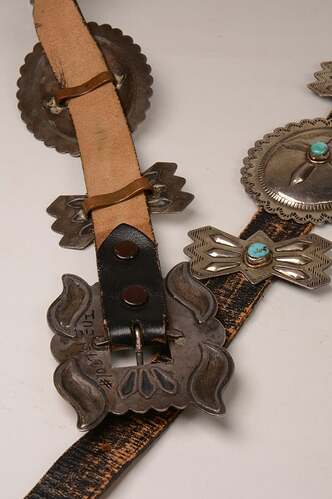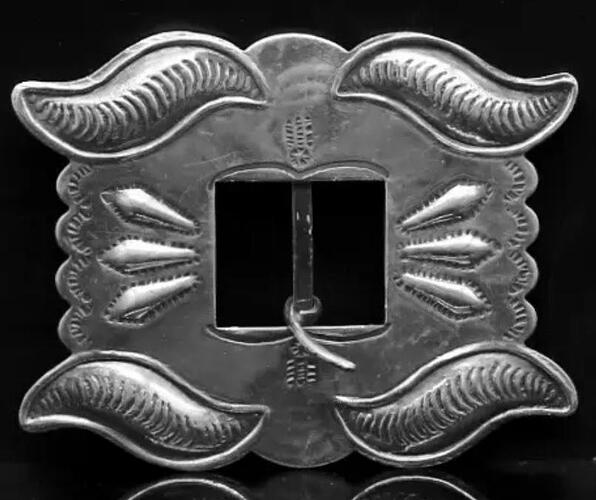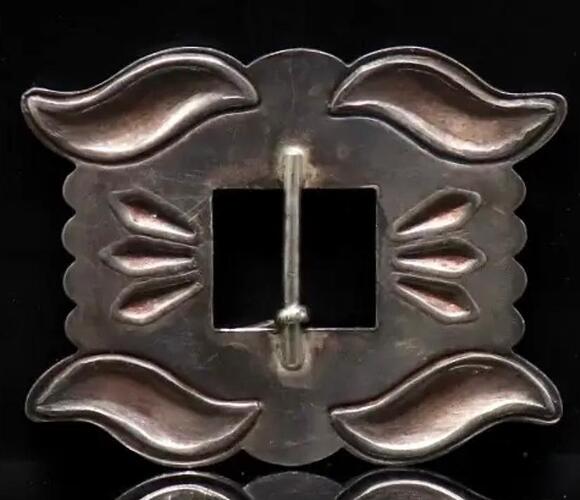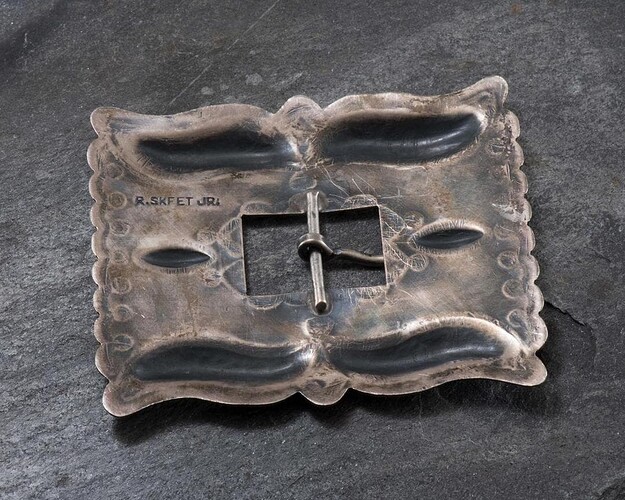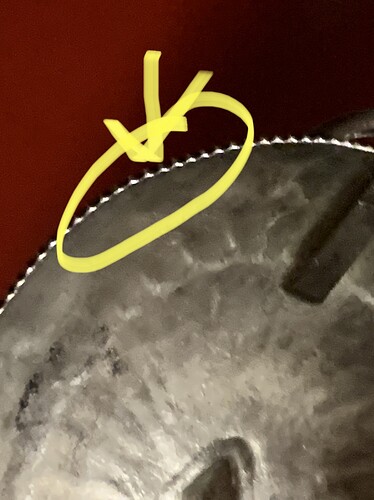Okay, I remember this thread well and thought your belt looked familiar. Made by a hydraulic press or not, it’s still a cool belt. 
@TaraFawn75 This belt was just listed on a reputable dealer’s website. Thought you would find it interesting, especially the dating being off so much from Jason’s knowledge of its origin.
Vintage Navajo Sterling Concho Belt with Turquoise $1,350.00
ca 1950-1960; Leather holes from 32" - 40"; Oval Conchos measure 2 3/4" x 3 1/8" ; Butterfly conchos 2 1/2" x 1 3/8", Buckle: 2 3/4" x 3 3/8" Fine stamping. Private Estate Collection. Excellent Condition
Using Jason’s picture as a guide - this is a pressed rather than hand stamped buckle? Does the listing specify the metal?
Edit - just re-read the listing title - seems like a killer deal for sterling
Another one of these buckles being sold on another reputable dealer’s website.
A Navajo buckle with silver sterling and stamping. This piece has repousse design with stamping on it. It measures 3 3/8 inches in length and 2 1/2 inches wide. There is no hallmark. $351.00
Again, no mention this buckle was made using a hydraulic press. Thanks to @Jason’s vast knowledge, because if I didn’t know better, I’d think I was purchasing a hand-wrought piece. To me, this “misrepresentation”, which is most likely unintentional, is an eye opener and disheartening.
To be fair, the hydraulic press is nothing more than a big hammer, it doesn’t create the stamps or the placement of the designs. Plus, there are hand stamped elements along with the pressed elements. I don’t think anyone begrudges artists for buying their metal stock rather than alloying, pouring the ingots, rolling out sheet or pulling wire.
Thanks for the clarification. When I heard" hydraulic press", I envisioned an all-in-one die that stamped out several entire buckles (shape, repousse, stampwork) all at once.
I don’t know. Re-examining the four buckles in this thread, to me, everything looks the same, except the stone settings. Basically, what Jason talks about here…
I guess it’s possible if there is a commercial impression die for that buckle they could stamp them out by the hundreds. I just don’t know enough to know if this buckle design is common or unique.
I had a press and used it to make jewelry; creating the impression die(s) was tedious work, tho some heard ‘press’ and thought easy peasy, nope. Plus, sawing out the design, making the bezels, setting the stones, cleaning up, polish or patina - finishing is easily half the work.
I don’t see anywhere in the description you posted (maybe I’m missing it) that it says it’s handwrought. So if it doesn’t say it’s handwrought, is that misrepresentation? For example, if turquoise isn’t stated to be natural I don’t immediately assume it is. I believe the problem would be if someone says a stone is natural and it’s stabilized. I would think the same thing might apply here.
You’re correct. The description doesn’t say handwrought either, but typically, this style of Navajo buckle is made by hand - cut silver, repousse, stampwork, etc. - one step at a time and doesn’t necessarily need to be described as handwrought, especially if being sold by a reputable dealer. It’s kind of assumed. But if a piece is made using an unconventional method such as a hydraulic press, where all of those steps are performed at once, I think it should be mentioned so the buyer knows what they are getting through this shortcut process. In other words, being a belt buckle collector, if I purchased this buckle thinking it was completely handmade (handwrought) and later discovered it was made using a hydraulic press, I would be very disappointed to say the least.
Again, I don’t believe either of these dealers were being intentionally deceptive. The reason I brought it up is because I’m suddenly seeing these buckles for sale and they’re catching my attention.
Im having a hard time figuring out pressed vs handwrought. So if the back is “flat” like my buckle below it’s handwrought? If the design is visible on back it’s pressed? Or no?
Not necessarily. My buckle below is “handwrought” according to this definition…
Handwrought
(ˈhændˌrɔːt ![]() )
)
ADJECTIVE
having been made or formed by hand rather than by machine.
I see, that makes sense. It looks as though even the little stamps are done by a press. Am I correct? They seem to have that line around their edge also. It looks completely different on the back.
Oooh I see the difference now when comparing TAH Handwrought Skeet buckle to the pressed ones! There is the raised outline on the pressed ones.
Yes, that’s what I’m thinking too, Zia, but I’m certainly no expert. All I know is when I hear the words “hydraulic press”, I get twitchy. 
Most likely folks are using a press for the butterflys & conchos too. I know I used my Tucker Tool dies and press to make components.
Is this a telltale sign a press was used? I’m referring to the outside ridges (feels like the outer end of a dime upon touch)
.
That looks like a deliberate decorative edge.
Hi Tara. Your buckle is hand stamped. A silversmith used a hammer and a stamp to emboss the design into the metal by striking the stamp very hard and very precisely with a hammer. Using a press is an entirely different process, as the press applies steady pressure to a stamp or die to impress a pattern into the metal.
Using a hand operated press, say a 20 ton bottle jack affixed to a steel frame is very much a hand process, whereas using a machine assisted press, or hammer to produce work is not generally considered a hand process.
If I’m using a combination of hand stamping, and say using a hand operated bottle jack to impress repousse into a concha or buckle, that’s still very much a handmade concha, or buckle.
If on the other hand I’m placing a piece of silver underneath a press, and stepping on an actuator, or pushing a button to press the pattern into the silver, that’s unquestionably machine made.
Hi again Tara. That edge was most likely created using a coarse checkering file to create the serrations. This was done by hand.

